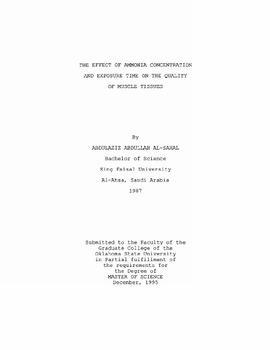| dc.description.abstract | Since different activities are involved in the trading of meat, cold storage facilities are one of the most important segments in any meat business. Chilling and freezing are greatly acknowledged as important forms of heat reduction. Meat manufacturers have utilized chilling and freezing as steadfast methods to preserve and prolong the shelf-life of meat and meat products. Ammonia is the oldest refrigerant utilized in the food industry today. Cold storage facilities using ammonia as a refrigerant are subjected to ammonia spill's from time to time depending on the level of awareness enhanced among the workers and the maintenance system advancement (Kramer et aI, 1981). The frequency of ammonia spills is difficult to assess due to the differences in the concentration of every spill and the location as well as the danger of the situation. Small leaks of ammonia are rarely reported to the Environmental Protection Agency. Yearly, 100 incidents of ammonia leaks, in food cold storage warehouses, have been estimated in The United States of America and Canada alone (Smith, 1987). Anhydrous ammonia (NH3 ) is widely known as the best refrigerant because of its advantages including excellent heat reduction properties, economical cost, and environmental safety (Arnold, 1993). Quality of meat and meat products exposed to ammonia in cold storage facilities was effected when the concentration of ammonia was very high (200,000 ppm) (Anil, 1971; Herrmann, 1965; Kassem, 1965). Contamination of meat and meat products is of great concern for both the processors and commercial cold storage warehouses. Changes in the quality of any meat exposed to ammonia have been estimated by the increases in the pH and ammoniacal nitrogen content of the meat surface as well as the acceptability of sensory evaluation scores. Increases of 1. 0 pH unit and 0.15 % of nitrogen content due to ammoniacal nitrogen after ammonia contamination in meat and meat products have been a guide for condemnation (Anon., 1981; Goodfellow et aI, 1978). Even though, several methods were established and used to evaluate changes in the quality of foods exposed to high levels of ammonia, there is a paucity of information for meat exposed to low levels of ammonia. Furthermore, the time and concentration of exposure to ammonia that may affect the quality of meat have not been well clarified. Demonstration of possible alterations in meat quality due to ammonia leakage has made it necessary to evaluate the merits of ammonia in meats and to determine the specific levels required to cause various meat items to be removed from the food distribution channel. Accessing such information will lead to better decision making whenever a spill occurs. Therefore, the main purpose of this research was to determine the effect of ammonia concentration and length of exposure on some of the quality attributes of beef, pork and chicken musculature. | |
